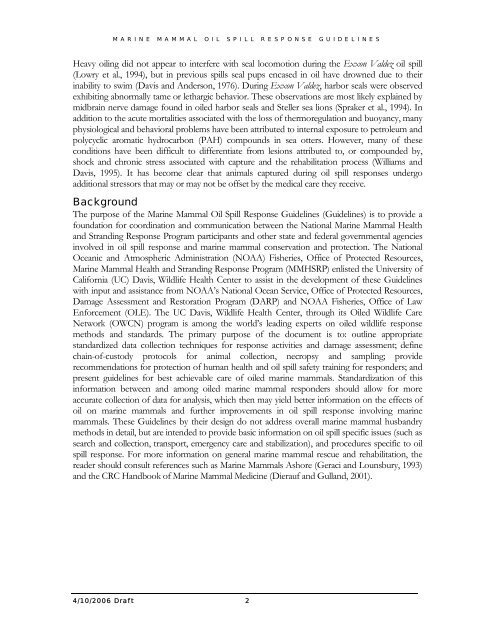Volume III, Appendices EM - National Marine Fisheries Service ...
Volume III, Appendices EM - National Marine Fisheries Service ...
Volume III, Appendices EM - National Marine Fisheries Service ...
You also want an ePaper? Increase the reach of your titles
YUMPU automatically turns print PDFs into web optimized ePapers that Google loves.
MARINE MAMMAL OIL SPILL RESPONSE GUIDELINES<br />
Heavy oiling did not appear to interfere with seal locomotion during the Exxon Valdez oil spill<br />
(Lowry et al., 1994), but in previous spills seal pups encased in oil have drowned due to their<br />
inability to swim (Davis and Anderson, 1976). During Exxon Valdez, harbor seals were observed<br />
exhibiting abnormally tame or lethargic behavior. These observations are most likely explained by<br />
midbrain nerve damage found in oiled harbor seals and Steller sea lions (Spraker et al., 1994). In<br />
addition to the acute mortalities associated with the loss of thermoregulation and buoyancy, many<br />
physiological and behavioral problems have been attributed to internal exposure to petroleum and<br />
polycyclic aromatic hydrocarbon (PAH) compounds in sea otters. However, many of these<br />
conditions have been difficult to differentiate from lesions attributed to, or compounded by,<br />
shock and chronic stress associated with capture and the rehabilitation process (Williams and<br />
Davis, 1995). It has become clear that animals captured during oil spill responses undergo<br />
additional stressors that may or may not be offset by the medical care they receive.<br />
Background<br />
The purpose of the <strong>Marine</strong> Mammal Oil Spill Response Guidelines (Guidelines) is to provide a<br />
foundation for coordination and communication between the <strong>National</strong> <strong>Marine</strong> Mammal Health<br />
and Stranding Response Program participants and other state and federal governmental agencies<br />
involved in oil spill response and marine mammal conservation and protection. The <strong>National</strong><br />
Oceanic and Atmospheric Administration (NOAA) <strong>Fisheries</strong>, Office of Protected Resources,<br />
<strong>Marine</strong> Mammal Health and Stranding Response Program (MMHSRP) enlisted the University of<br />
California (UC) Davis, Wildlife Health Center to assist in the development of these Guidelines<br />
with input and assistance from NOAA’s <strong>National</strong> Ocean <strong>Service</strong>, Office of Protected Resources,<br />
Damage Assessment and Restoration Program (DARP) and NOAA <strong>Fisheries</strong>, Office of Law<br />
Enforcement (OLE). The UC Davis, Wildlife Health Center, through its Oiled Wildlife Care<br />
Network (OWCN) program is among the world’s leading experts on oiled wildlife response<br />
methods and standards. The primary purpose of the document is to: outline appropriate<br />
standardized data collection techniques for response activities and damage assessment; define<br />
chain-of-custody protocols for animal collection, necropsy and sampling; provide<br />
recommendations for protection of human health and oil spill safety training for responders; and<br />
present guidelines for best achievable care of oiled marine mammals. Standardization of this<br />
information between and among oiled marine mammal responders should allow for more<br />
accurate collection of data for analysis, which then may yield better information on the effects of<br />
oil on marine mammals and further improvements in oil spill response involving marine<br />
mammals. These Guidelines by their design do not address overall marine mammal husbandry<br />
methods in detail, but are intended to provide basic information on oil spill specific issues (such as<br />
search and collection, transport, emergency care and stabilization), and procedures specific to oil<br />
spill response. For more information on general marine mammal rescue and rehabilitation, the<br />
reader should consult references such as <strong>Marine</strong> Mammals Ashore (Geraci and Lounsbury, 1993)<br />
and the CRC Handbook of <strong>Marine</strong> Mammal Medicine (Dierauf and Gulland, 2001).<br />
4/10/2006 Draf t 2
















